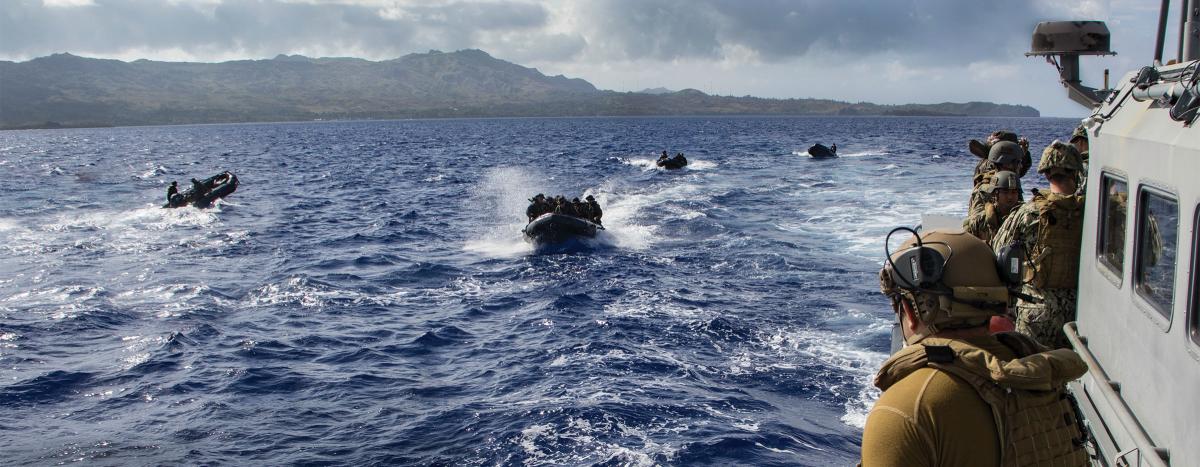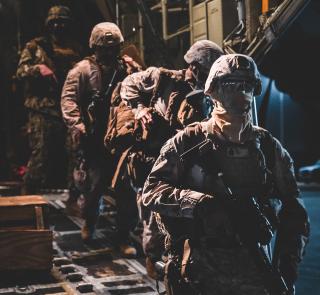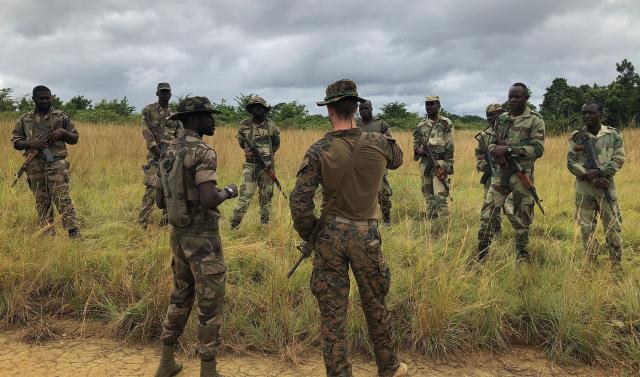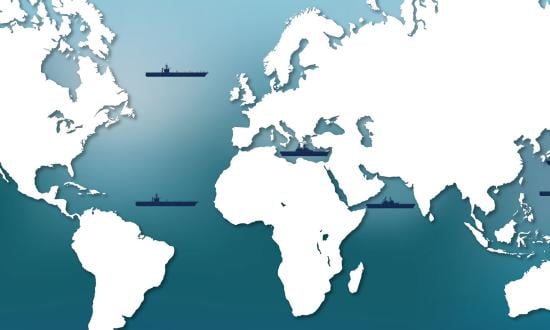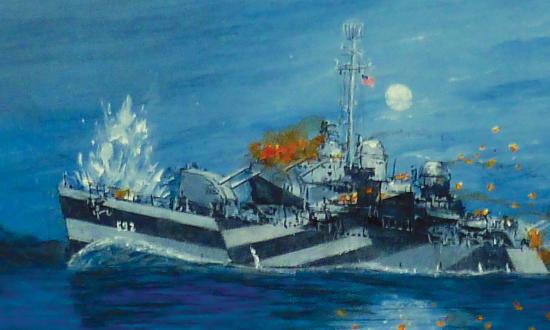The Concept for Expeditionary Advanced Base Operations (EABO) could lead to a foundational transformation of the Marine Corps, making it a naval expeditionary force fully capable of enabling sea denial and sea control, while also supporting the sustainment of the fleet.1 By operating forward, inside contested maritime spaces, the Marine Corps will become the nation’s premier contact-layer force, extend the power of the fleet, and facilitate naval and joint follow-on forces’ entry into contested theaters.2
The Concept for Expeditionary Advanced Base Operations leverages many of the Marine Corps’ traditional strengths, including its expeditionary nature and naval character. However, two of the Marine Corps’ strongest suits are missing—security cooperation (SC) and foreign security forces (FSF) advising. The Marine Corps has an SC and FSF advising legacy; Marine expeditionary forces consistently plan SC activities, and it is almost guaranteed that deployed Marine expeditionary units will conduct theater SC.3
The Marine Corps has a unique opportunity to exploit its SC expertise to fulfill the promise of this naval warfare concept. As described in the Tentative Manual for Expeditionary Advanced Base Operations, modern adversary sensors and weapons demand “an operational approach that treats the littorals as a single, integrated battlespace. Doing so requires . . . the projection of naval expeditionary forces into or from a foreign country and its adjacent waters.”4 The aim of SC is access to the host country. Instead of “fighting to get to the fight,” or otherwise deploying forces to conduct EABO in response to crisis escalation, SC can provide naval commanders with persistent access before the fight begins. In this way, SC can mitigate the vulnerabilities of EABO, providing a contact layer that can persist forward indefinitely and extend the power of the naval force.
EABO and Persistence
EABO is the employment of naval expeditionary forces within contested maritime areas to conduct sea denial, support sea control, or enable fleet sustainment.5 Perhaps the most visible manifestation of EABO is use of long-range precision fires in and around key maritime terrain. This was demonstrated recently with the employment of the Navy/Marine Corps Expeditionary Ship Interdiction System (NMESIS) during Large Scale Exercise 21. This unmanned, mobile fires system fired a Naval Strike Missile and sank its target, the decommissioned guided-missile frigate Ingraham.6 The applications for sea control and sea denial abound. A Marine littoral regiment, deploying a series of NMESIS systems across an island chain, would hold an adversary’s fleet at risk. This could deter an adversary from escalating aggression, pressure them into deescalation, or cripple an enemy fleet should the threshold of conflict be crossed.7
But NMESIS does not operate in a vacuum. The targets it strikes must first be detected by sensors, many of which will be provided by forces conducting EABO. Its magazine capacity is limited, and resupply must be possible for it to have a significant effect. And, perhaps most elementary but also most essential, it must be there when it counts.
The Tentative Manual for Expeditionary Advanced Base Operations mentions some variation of the word “persist” 35 times, emphasizing the importance not only of presence, but also the ability to maintain it. The harshest criticisms of EABO highlight both the problem of access and the challenge of sustainment as key vulnerabilities.8 While the Tentative Manual discusses tactical considerations for the commander managing sustainment, there is a gap in the operational and strategic plans for how to access this key maritime terrain.
If U.S. forces are not on U.S. soil, then permission must be gained and maintained from the host country to place sensors, shooters, and naval expeditionary forces within its borders. This becomes increasingly difficult after escalation begins. Moreover, if such forces are not present prior to hostilities, they have no deterrence value, and their use as a contact layer becomes void. To be truly effective, the contact layer cannot be deployed after the fighting starts; it must already be there—waiting, watching, and ready.
A Security Cooperation Legacy
Security cooperation includes Department of Defense (DoD) programs and activities involving “interaction with the security establishment of a foreign country to build capabilities, provide access, or build relationships.”9 Such activities include train-and-equip missions, operational support, defense institution building, exercises, and exchanges, among others.10 SC is closely related to but distinct from security assistance, which includes similar activities controlled by the Department of State, although DoD administers many security assistance activities.
Over the course of the 20th century, the Marine Corps conducted SC so frequently that it earned a reputation as the military arm of the State Department.11 As the demand for SC continued to grow, so too did the requirement for a unit that would serve as the lead agent for SC programs and training. In 2011, the Marine Corps consolidated its SC training and advising units into the Marine Corps Security Cooperation Group (MCSCG), which plans, coordinates, executes, and manages all Marine Corps SC activities and programs.12 However, the MCSCG is in the process of deactivating, presumably because of a perceived reduced utility with the end of the wars in Iraq and Afghanistan.
The Promise of Security Cooperation
The Marine Corps is not mandated by law to conduct SC. Its Title 10 responsibilities are clearly and appropriately naval in character. If one aimed to read a SC mission into Marine Corps responsibilities, it would be within the catch-all requirement to conduct “such other duties as the president may direct.”13 But for a litany of historical reasons, the service inherited and developed a penchant for SC, and a significant proportion of those Marines with operational experience in the Middle East have completed tours as FSF advisors.14
Looking at the problem of EABO through the lens of a seasoned force of SC professionals, a solution seems apparent: Leverage Marine Corps SC to gain and maintain access to persist forward indefinitely.
U.S. allies and partners exist within the weapons engagement zones (WEZs) of shared adversaries. SC teams frequently are deployed to work alongside ally and partner security forces, placing them exactly where the Navy and Marine Corps hope to conduct EABO. Rather than seeking to deploy contact-layer forces into the WEZ amid hostilities, a simpler and more sustainable solution would be to retask Marines already in the right place at the right time. Deployed Marines conducting SC will be in the right place, and by rotating SC missions into theater, they will always be there at the right time. Consequently, the Marine Corps should design a concept of employment for SC ensuring Marines are deployed forward to simultaneously execute or be retasked to execute EABO tasks.
Vignettes
What follows are a few examples illustrating what such SC and EABO integration could look like:
Sensor Teams. A small Marine Corps team is deployed to Samoa, charged with the overt mission of training the Samoa Police Service to use a suite of highly capable sensors that will enhance Samoan maritime policing. While in country, they carry out their secondary mission of using other sensors to identify and track Chinese shipping participating in the exploitation of Tonga.15
Combined Patrolling and Clandestine Logistics. A Marine Corps platoon is deployed to Vietnam to overtly conduct joint maritime patrols with the Vietnamese Navy and police illegal fishing. Simultaneously, the SC team builds a network of suppliers and constructs an expeditionary advanced base near Haiphong harbor, builds a cache of supplies required for EABO tasks, and establishes relationships with local contractors who will serve as a local means of sustainment in future operations.16
NMESIS Training and Flipping the Switch. A company from a Marine littoral regiment is training its Philippine counterparts in the NMESIS system and is arrayed across Philippine islands in the vicinity of the Luzon Strait. Regional tensions suddenly flare, and China initiates a naval blockade of Taiwan. Dynamically retasked, the Marine Corps company acquires a squadron of People’s Liberation Army-Navy (PLAN) ships as targets. Under the threat of this squadron’s destruction, China is pressured to end the blockade.17
Integration with Fleet Operations
Because of their small footprint, Marine SC teams can be deployed in anticipation of fleet operations. This would place some capability for sea denial and sea control ashore ahead of Navy ships en route to the area of operations. Moreover, such teams do not need to be attached to a specific deploying ship, squadron, or group, but could serve in a general support capacity. As Navy ships enter the area of operations, the SC team would be temporarily tethered to that ship and support its requirements for sea denial or control as required.
Further, these SC teams could contribute to building caches of resources for sea denial and sea control while on the ground conducting SC in each country. Rather than building the iron mountain of equipment seen in the Marine Corps Prepositioning Program–Norway, this program would build smaller, lighter caches stored in multiple areas throughout a country, giving greater flexibility while also mitigating the EABO challenges of magazine depth and sustainment. At the same time, these caches could be used by allies and partners to provide sea control and sea denial themselves, having received training in these tasks from Marine Corps SC teams, amplifying the collective naval power of a coalition.
Winning Buy-In for Security Cooperation
The access the United States desires is predicated on fulfilling a desire of the ally or partner. SC as an EABO supporting concept must be packaged as something the ally or partner is interested in. This is not too different from the challenge facing EABO as a concept—winning support from naval and joint commanders. The “customer” must want what you are selling. Critically, the Marine Corps must show the “customer” why it wants a given SC offering.18
The previous example of Samoa is illustrative. Samoa has no standing army and may have no interest in hosting or receiving training in long-range precision fire systems such as NMESIS. However, the Samoa Police Service—a unitary national police force—may be very interested in C4ISR systems that add to its capacity to monitor and police its territorial waters. A Marine Corps SC team sent to train Samoan police in these systems could, with Samoan endorsement, be authorized to use these or similar C4ISR systems to add to Seventh Fleet and III Marine Expeditionary Force’s sensor networks.
In the pursuit of this buy-in, Marine Corps SC planners must continue to work hand-in-glove with U.S. embassy teams, specifically their offices of defense cooperation (ODCs). By leveraging the invaluable personnel in each ODC, most of whom develop personal relationships essential to diplomatic work of any kind, planners can identify the force packages U.S. allies and partners are seeking, build them, and win support for integration of EABO-enabling activities.
Security Cooperation is an Investment in EABO
The Concept for Expeditionary Advanced Base Operations integrates many of the Marine Corps’ key strengths yet sidesteps its notable capability for SC and FSF advising. In turn, the Tentative Manual for Expeditionary Advanced Base Operations briefly references the use of SC, but only in the context of periodic and intermittent use of cooperative security locations in preparation for the arrival of littoral forces during contingencies.19 And while the Marine Corps still possesses a plethora of Marines with SC and FSF experience, the nucleus of this capability, the MCSCG, is slated for deactivation.
To pursue EABO, the Marine Corps had to divest to reinvest. But retaining the service’s strength for SC would not be a distraction from EABO. Instead, SC can significantly increase the Marine Corps’ ability to deliver on EABO’s intent. By securing persistent access to those host countries within the WEZ of shared adversaries, the Marine Corps can mitigate the risks to sustainment and force projection that would otherwise undermine the feasibility of employing contact-layer forces.
By doubling down on SC, the Marine Corps can ensure that naval expeditionary forces can persist forward indefinitely and extend the power of the fleet. Ultimately, SC integrated with EABO will provide the Navy–Marine Corps team with a means of sea denial and sea control by always being in the right place at the right time.
1. Office of the Chief of Naval Operations and Headquarters, U.S. Marine Corps, Concept for Expeditionary Advanced Base Operations (Washington, DC: Department of the Navy, 2019), 3.
2. Gen David H. Berger, USMC, 38th Commandant’s Planning Guidance (Washington, DC: Headquarters, U.S. Marine Corps, 2019), 1.
3. Headquarters, U.S. Marine Corps, NAVMC 3500.99: Marine Expeditionary Unit Training and Readiness Manual, 13 November 2012 (Washington, DC: Headquarters, U.S. Marine Corps, 2012), 2–2.
4. Headquarters, U.S. Marine Corps, Tentative Manual for Expeditionary Advanced Base Operations, 1st ed. (Washington, DC: Headquarters, U.S. Marine Corps, 2021), 1–3.
5. Tentative Manual for Expeditionary Advanced Base Operations, 1–3.
6. Kelly Flynn, “Marine Corps Successfully Demonstrates NMESIS during LSE 21,” Marine Corps Systems Command, 17 August 2021.
7. Tentative Manual for Expeditionary Advanced Base Operations, 1–4.
8. Ben Wan Beng Ho, “Shortfalls in the Marine Corps EABO Concept,” U.S. Naval Institute Proceedings 146, no. 7 (July 2020).
9. Defense Security Cooperation University, Security Cooperation Management, 41st ed. (Arlington, VA: Defense Security Cooperation University, 2021), 1–7.
10. Security Cooperation Management, 1–7 to 1–15.
11. See, Nicholas J. Schlosser, “Small Wars Manual: An Old Solution to a New Challenge?” Fortitudine 35, no. 1 (Quantico, VA: Marine Corps History Division, 2010): 4–9; Ronald Hays, Combined Action: U.S. Marines Fighting a Different War, August 1965 to May 1971 (Quantico, VA: Marine Corps History Division, 2019), 50; Jerry Meyerle, Megan Katt, Jim Gavrilis, On the Ground in Afghanistan: Counterinsurgency in Practice (Quantico, VA: Marine Corps University Press, 2012), 53–60.
12. Marine Corps Security Cooperation Group, “MCSCG Command Information."
13. 10 U.S. Code § 8063 (a).
14. Headquarters, U.S. Marine Corps, “MARADMIN 239/19, Advanced Foreign Security Forces (FSF) Advisor Experience Track Screening Panel Announcement,” 16. April 2019.
15. Susannah Luthi, “Meth, Vanilla, and ‘Gulags’: How China Has Overtaken the South Pacific One Island at a Time,” Politico, 29 August 2021.
16. Reuters staff, “U.S. Delivers Six Patrol Boats to Vietnam Amid Deepening Security Ties,” Reuters, 1 April 2019.
17. J. Michael Cole, “The Third Taiwan Strait Crisis: The Forgotten Showdown Between China and America,” The National Interest, 10 March 2017.
18. Andy Lake, New Zealand and Samoa Security Cooperation Brief (Office of Defense Cooperation, U.S. Embassy, New Zealand), 15 October 2019.
19. Tentative Manual for Expeditionary Advanced Base Operations, F–2.



